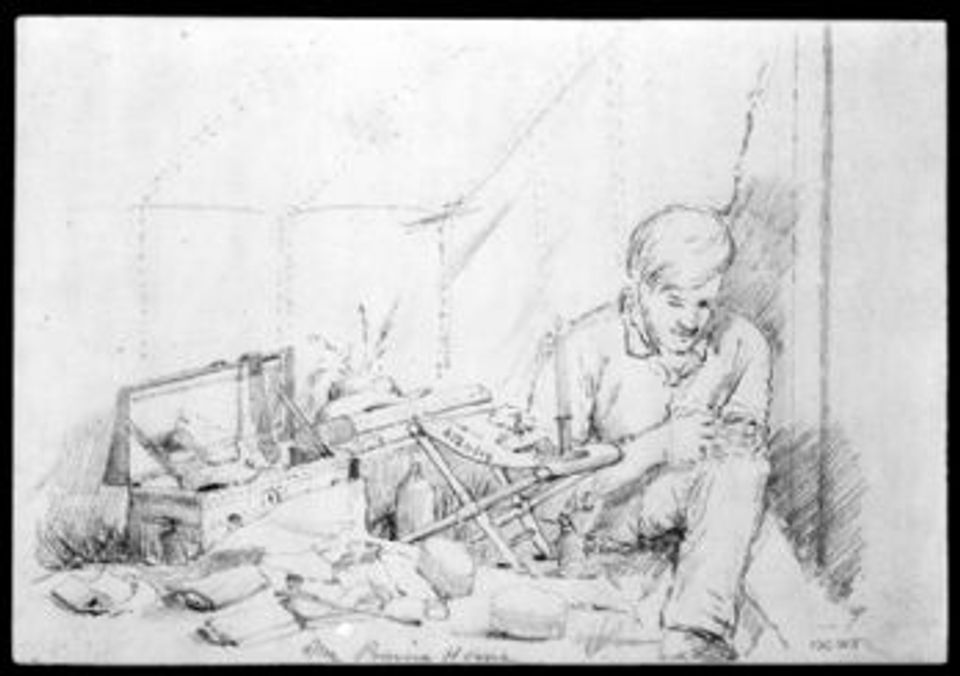John Mix Stanley

- Biography
During the 1830s Stanley was an itinerant sign and portrait painter, traveling between Detroit and Chicago. In 1839, while in Fort Snelling, Minnesota, he painted Indian subjects and landscapes. Three years later he was at Fort Gibson, Oklahoma, gathering Indian material and painting portraits, which he exhibited in Cincinnati in 1846. In that year he also accompanied Colonel Stephen Kearny from Santa Fe, New Mexico, to San Diego [California], producing images for Kearny's official expedition report.
In 1847 Stanley traveled up the Pacific Coast to sketch native Americans. For the next two years he lived in Hawaii, painting portraits of the native inhabitants. In 1849–50 he toured his Indian Gallery in the East. Although Congress declined to purchase his 150 canvases, the paintings remained in the Smithsonian Institution in Washington, D.C., where they were destroyed by fire in 1865. Another collection of his work was lost under similar circumstances at P. T. Barnum's museum in New York.
In 1853–54 Stanley accompanied Isaac Stevens's Pacific Railway Survey as photographer and artist. Stanley spent the rest of his life repainting his lost works and organizing their exhibition, sale, and reproduction.
William Truettner, ed The West as America: Reinterpreting Images of the Frontier, 1820–1920 (Washington, D.C. and London: Smithsonian Institution Press, 1991)
- Artist Biography
Born 1814, Canandaigua, N.Y. 1828, orphaned; apprenticed to a coachmaker. 1834, moved to Detroit as house and sign painter. 1835, studied with James Bowman, a portraitist trained in Italy. 1836–38, painted portraits around Chicago. 1839, Fort Snelling, Minn., began to concentrate on Indian portraits and scenes. Returned East; saved enough painting portraits and taking daguerreotypes to enable him to go West again in 1842. Set up studio, Fort Gibson, Oklahoma Territory; painted frontiersmen and Indians. Lived in Indian country until 1845, painting grand Indian council at Tallequah (1843) and a second council of prairie Indians. 1846, became artist with Kearny military expedition to California. 1847, painted Indian portraits in Oregon Territory; 1848–49, Polynesian portraits in Hawaii.
1850–51, displayed his Indian Gallery in cities in the East. 1851, displayed 150 paintings in Smithsonian (catalogue, 1852); offered to U.S. government for $19,200 plus $12,000 in expenses. 1853, official artist for Stevens expedition, northern railway survey, from St. Paul, Minn., to Puget Sound, Wash. Used field sketches to paint enormous panorama containing forty-two scenes of western life (now lost).
Married, 1854. Congress refused to purchase Indian Gallery; collection largely destroyed by fire, 1865. Fire at P.T. Barnum's American Museum, New York, destroyed more of his Indian paintings. Died 1872, Detroit, Mich.
Although many works in Stanley's large oeuvre of Indian paintings were destroyed by fire, many more survive than is generally thought. The five in the NMAA constitute a significant group. Although he traveled as widely as George Catlin in quest of his subject, Stanley differs from Catlin in that he made his initial records of Indian life with camera and pencil and postponed execution of his paintings until after his expeditions. He also organized his canvases in a self-conscious, academic manner; and lacking Catlin's empathy with the Indians and their cultures, he viewed them as an outsider, with no little condescension. In one sense, his paintings are valuable precisely as documentation of that widely shared attitude.
William Kloss Treasures from the National Museum of American Art (Washington, D.C. and London: National Museum of American Art with the Smithsonian Institution Press, 1985)
Luce Artist BiographyJohn Mix Stanley began as an apprentice to a wagonmaker. He later worked as a sign painter in Detroit, and had no art training until 1835, when he met and formed a partnership with Philadelphia painter James Bowman. Stanley had an adventurous spirit and before long he took to the road as an itinerant portrait painter, traveling from New York to Minnesota. With the outbreak of the Mexican War in 1845, he joined Colonel Kearney's expedition to California, producing many sketches and paintings of the campaign. He traveled up and down the Pacific Coast, painting the Native American tribes, and even shipped out to Hawaii to document the natives there. In 1849 and 1850, Stanley toured his "Indian Gallery" on the East Coast, but despite his hopes, Congress declined to purchase his one hundred and fifty canvases. The paintings remained on view at the Smithsonian Institution until a fire destroyed them in 1865. That same year, another fire, at P. T. Barnum's American Museum, consumed more of Stanley's work, and he spent the later years of his life using his field sketches to re-create his paintings. (Truettner, ed., The West as America, 1991)













